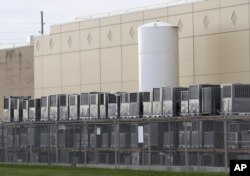Editor’s note: President-elect Donald Trump and the Carrier Manufacturing Corporation claim that more than 1,000 jobs will remain in Indiana thanks to a deal struck between the incoming administration and Carrier.But several news organizations, as well as the head of the union representing many Carrier workers, say the actual number of jobs saved is around 800.VOA attempted to verify how many jobs were preserved, however the public relations department at United Technologies Corp., Carrier’s parent company, is not accepting questions from the media.
Donald Trump’s deal with air conditioning manufacturer Carrier Corporation to keep nearly 1,000 jobs in the Midwestern state of Indiana could be a preview of an interventionist approach he may adopt when he assumes the presidency next month, according to a U.S. business analyst.
Carrier agreed not to shift the jobs to Mexico after a lobbying effort from the incoming Trump administration. Carrier made the agreement in exchange for new government incentives, according to a person familiar with the situation.
When asked about the significance of the deal, American Enterprise Institute Resident Scholar Claude Barfield told VOA, “I would focus [instead] on the goon squad tactics of the incoming Trump administration.”
Two weeks ago, Trump telephoned the CEO of Carrier’s parent company, United Technologies, according to a source close to the company, and asked him to reconsider shuttering the air conditioning plant.
The source said CEO Greg Hayes told Trump that sending the lower-wage, high-turnover jobs to Mexico would save his company $65 million a year.
Trump responded that United Technologies would reap much greater financial benefits from corporate tax cuts he planned to implement, the source said.
During stops on the campaign trail, Trump occasionally threatened Carrier with steep tariffs on any exports from Mexico.
Barfield said the president-elect’s involvement in a company’s business affairs sets “a bad precedent.”
“The message to companies is if we need something, just threaten to send jobs to Mexico or somewhere else and the government will step in and give us more than we need for recompense,” Barfield said.
Lee Branstetter, a nonresident senior fellow at the Peterson Institute for International Economics, told VOA the pact “is just completely divorced from reality.”
Because the United State is close to full employment and with Trump’s promises to cut taxes and boost federal spending possibly on the horizon, Branstetter said the confluence of events may nudge interest rates slightly higher and drive up the value of the dollar.
“Stuff made in America made by the American dollar becomes more expensive on foreign markets,” Branstetter added.
The incoming Trump administration vows to create 25 million new jobs over the next 10 years. The president-elect has said it would rebuild the nation’s infrastructure, scrap or revamp existing trade deals, and implement a “pro-growth tax plan” and a new regulatory framework.
Barfield, of the American Enterprise Institute, predicted whatever the path the incoming administration ultimately takes, lost manufacturing jobs will not return to the United States.
He said for more than a half century, the U.S. economy has shifted from a manufacturing to a largely service economy, primarily due to technological advances that greatly reduced the need for factory jobs and China’s entry into the global lower-end manufacturing sector.
Barfield added the service industry, not the manufacturing sector, is where many employment opportunities are and will be for years to come for American workers.
“When you say service industry, you’re not talking about Burger King or McDonald’s, you’re talking about more likely business services because in the world of the Internet you really need all of this infrastructure behind it. So it’s data and that means we need a work force that’s much better trained.”








